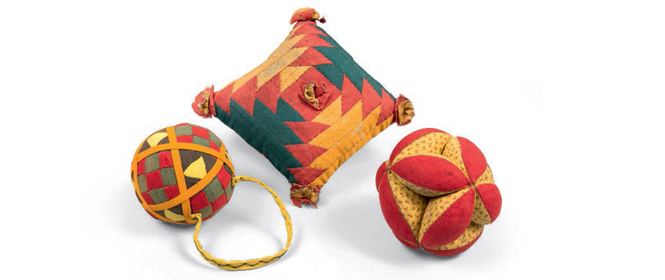
Amish Pincushions
What have pincushions got to do with Protestantism? As part of our “What’s That For?” series, Anne-Katrin Ziesak (curator and project manager of “The Luther Effect: Protestantism – 500 Years in the World”) explains this surprising relationship.
Even today, many Baptists – including the majority of Amish, many members of the Church of the Brethren, and some Mennonites – do not use buttons on their clothing as an expression of their ideal of simplicity. Women’s dresses are fastened by metal hooks or cylindrical pins. Owing to the large quantity of pins and needles required for the various people living in a large household, the custom was to make pincushions of all different kinds and sizes for their safekeeping. Historically, these cushions were made using colourful materials and fanciful shapes, which meant they could also be used as decorative objects. Sometimes they would be hung from shelves or displayed in glass-fronted cabinets. Using suspension loops, it required great technical skill to sew together the 86 tiny squares and triangles that made up the “piecework ball”. The red-yellow “puzzle ball”, comprising twelve padded elliptical pieces, was a form popular in the late-19th century with the Amish and Mennonite communities of Southeast Pennsylvania. The use of single-colour (rather than printed) fabric suggests that this is an example of Amish craftsmanship.
Great Britain’s North American colonies offered space to create a wide array of religious utopias. Upon founding his colony in 1681, the Quaker William Penn hoped to carry out a “religious experiment”. He wanted to create a refuge for his religious brothers and sisters, where they could escape persecution in Europe. Unlike colonies in which Puritans and Anglicans set the agenda, Pennsylvania was to be a haven of religious tolerance. The promise of tolerance and economic opportunities proved to be immensely attractive. In addition to English, Welsh, and Scottish Quakers, Anglicans, and Presbyterians, there were also many Protestant immigrants from the German-speaking regions of Europe. The first colonists comprised Baptist groups, including Mennonites, Amish, and Brothers of Schwarzenau (a split from the latter group subsequently produced the Ephrata Cloister). They were in turn followed by members of the Schwenkfelder Church, Moravian Brethren, Lutherans, and Calvinists.
The Pennsylvanian “Holy Experiment” is one of the themes explored in the American section of our major exhibition, “The Luther Effect: Protestantism – 500 Years in the World”. You can learn more about Protestantism in all its diversity in the United States – as well as Sweden, Korea, and Tanzania – at the Martin-Gropius-Bau until 5 November 2017.